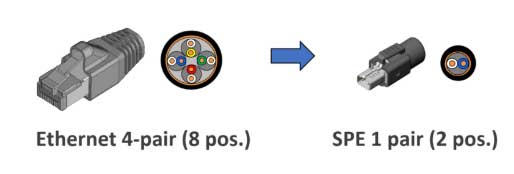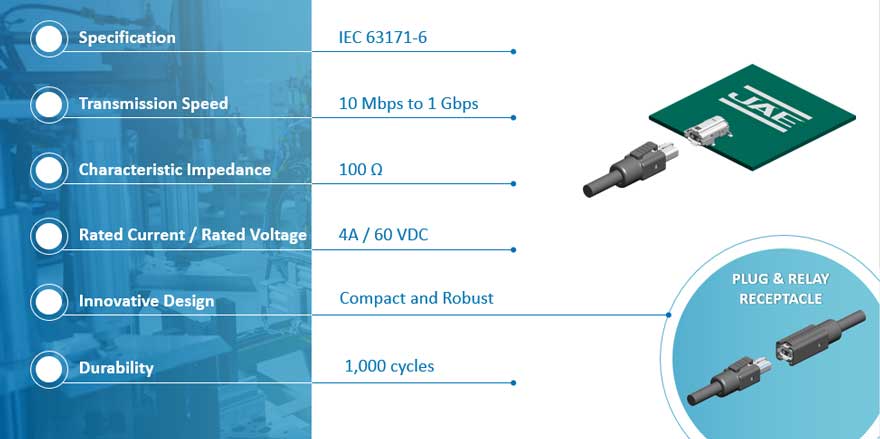JAE Japan Aviation Electronics Industry, Ltd introduced DZ17 series of the next generation single pair ethernet connector.
As the digitalization of society progresses, information and communication technologies are becoming increasingly important. “Ethernet” is the most typical communication-network standard used in wired Local Area Networks (LAN).
Ethernet has become more popular in equipment of all varieties, such as personal computers, various home appliances, industrial equipment, social infrastructure, automobiles and several other applications, and has become essential to our life.
On the other hand, further evolution of Ethernet technology is required due to the increasing sophistication of the information and communication technologies. In fact, what is expected of Ethernet includes the improvement of rationalization and efficiency of networks, the increase of transmission speeds, the extension of transmission distances, size and weight reduction, wiring simplification, and more environmental friendliness.
Practical Use of Next Generation Ethernet Standard SPE is Progressing

Under these circumstances, “SPE (Single Pair Ethernet)” has been established as the next generation Ethernet standard and its practical uses are gradually progressing.SPE uses a single pair (two cores) for Ethernet communication, which used to require up to four pairs (eight cores), and that simultaneously allows power supply (compatible with PoDL).
In addition to connectors and cables being smaller, SPE can also significantly reduce the size of the board mounted components, contributing to smaller and lighter equipment. It can now be installed in equipment that previously have been difficult to miniaturize because of the Ethernet component mounting requirements.In comparison with the conventional Ethernet (Standard Ethernet), the amount of copper used in cables is reduced by one-fourth and has become more energy efficient, which has great benefits from the SDGs perspective.
SPE has been put into practical use in vehicles since the 2010s, and its installation as in-vehicle Ethernet is steadily increasing. Furthermore, in addition to the leading automotive applications, it has also become popular in industrial equipment. In the future, it is expected to be installed in ICT equipment and become widespread as a replacement for the current standard Ethernet.
DZ17 Series Product Specifications
The DZ17 Series, SPE connector from JAE is an IEC63171-6 standard compliant connector (non-waterproof type). With this connector Ethernet communication which conventionally required two or four pairs of wires, can now be supported with a single pair.
The connector series is also compatible with IEEE 802.3cg/bw/bp Ethernet standards for data rates of 10 Mbps, 100 Mbps, and 1 Gbps. The rated current and voltage are 4A and 60VDC, respectively, with ingress protection rating of IP20. The tensile strength is 50 N minimum, and mating durability is 1,000-cycles.

New Development of Compact, Lightweight and Easy to Connect Products
The DZ17 Series SPE connector has a compact and lightweight plug design with a tool-less IDC wire termination option for easy assembly. The product lineup includes plugs with solder or IDC termination, right-angle and straight receptacles, and relay receptacles with solder and IDC termination structures.
In the future, JAE will be promoting the connector series into factory automation (FA), building automation (BA), process automation (PA) and various relevant applications, where the need for SPE connectors will become common. The SPE connectors are also being considered for use in image transmission systems, such as network cameras, and are expected to be widely used in general through out industrial applications.

Participating in SPE Consortia in Japan and in the World
JAE participates in the SPE Industrial Partner Network (headquartered in Germany), an international consortium for SPE connectors, and is developing compatible products in commercialization of SPE connectors Major connector manufacturers and FA equipment manufacturers from around the world participate in it the SPE consortium with main target markets being in the FA fields.
In promoting corresponding activities JAE also participates in the Single Pair Ethernet Consortium (SPEC), a Japanese consortium established in March 2022, with the aim of popularizing SPE in Japan.






